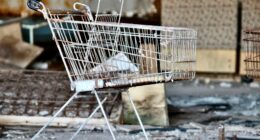Cosmopolitanism emphasizes the need to transcend boundaries while recognizing each other’s cultures, values and beliefs. Globalization, on the other hand, focuses more on economic interdependence through an increase in global interconnectedness. Both of these ideas are important for understanding our world today and how the global environment is changing.
What is cosmopolitanism?
(Photo by Stephanie McCabe on Unsplash )

The term “cosmopolitanism” has been used in a variety of ways, but it generally refers to the idea that all humans are part of a single community. This community can be defined in terms of shared values, common ideals, or simply a sense of shared humanity.
Cosmopolitanism is often contrasted with nationalism, which emphasizes the importance of one’s own nation or culture above all else. Globalization is also sometimes seen as the opposite of cosmopolitanism, since it involves the spread of homogenous cultural values around the world.
However, it is important to note that cosmopolitanism and globalization are not necessarily mutually exclusive. In fact, many thinkers have argued that cosmopolitanism is actually necessary for globalization to work properly. Without a sense of shared community and shared values, they argue, globalization will simply lead to chaos and conflict.
What is globalization?
(Image by stokpic from Pixabay )

Globalization is the process of increased interconnectedness among societies around the world. The term is often used to refer to economic globalization, the integration of national economies into the global economy through trade, investment, and capital flows. Globalization has also been accompanied by an increase in cultural exchanges and the spread of new ideas and technologies across borders.
The difference between cosmopolitanism and globalization
There are a few key ways in which cosmopolitanism and globalization differ. For one, globalization is largely driven by economic forces, while cosmopolitanism is more of a social or cultural phenomenon. Additionally, globalization tends to emphasize the interconnectedness of people and places, while cosmopolitanism emphasizes the idea of cultural diversity and tolerance. Finally, globalization typically leads to homogenization as people and cultures become more alike, while cosmopolitanism leaves room for individual cultures to maintain their distinctiveness.
What is the difference between globalization and glocalization?
Globalization is the process of expanding world trade, contacts among societies, and the sharing of ideas around the world. Glocalization is a term used to describe the way in which global companies tailor their products and services to meet local cultures and preferences.
While globalization refers to the increasing interconnectedness of the world, glocalization is about adapting to local markets. Global companies often use glocalization as a strategy to enter new markets.
An example of globalization would be Coca-Cola selling its products in over 200 countries. An example of glocalization would be Coca-Cola creating a special recipe for its products sold in China that takes into account Chinese preferences for sweeter drinks.
What are the advantages and disadvantages of cosmopolitanism?
Advantages of cosmopolitanism:
- Cultural diversity: Cosmopolitanism promotes respect for cultural diversity, recognizing that individuals from different backgrounds have unique experiences and perspectives that contribute to a richer understanding of the world.
- Global perspective: Cosmopolitanism encourages individuals to view the world as a global community, promoting cooperation and understanding across borders.
- Openness to new ideas: Cosmopolitanism values the exchange of ideas and encourages individuals to be open to new and different perspectives, which can lead to personal growth and intellectual development.
- Humanitarian values: Cosmopolitanism emphasizes the importance of universal human rights and promotes empathy and compassion for all individuals, regardless of their nationality or cultural background.
Disadvantages of cosmopolitanism:
- Cultural imperialism: Cosmopolitanism can sometimes be seen as promoting a Western or dominant cultural perspective, which can lead to the erasure or marginalization of other cultures.
- Identity loss: Emphasizing a global community can sometimes lead to a loss of individual or cultural identity, particularly for marginalized communities.
- Elitism: Cosmopolitanism can sometimes be associated with elitism or a sense of superiority among those who consider themselves “global citizens” or part of a cosmopolitan community.
- Lack of practicality: Cosmopolitanism can be seen as a philosophical ideal rather than a practical solution to global problems, and may not always be feasible or applicable in real-world situations.
What are the advantages and disadvantages of globalization?
Advantages of globalization:
- Increased economic growth: Globalization can lead to increased trade and investment, which can stimulate economic growth and create jobs.
- Greater consumer choice: Globalization can increase the availability of goods and services, providing consumers with a wider range of choices and lower prices.
- Cultural exchange: Globalization can lead to greater cultural exchange and understanding, as people from different parts of the world interact and share their experiences and perspectives.
- Technology transfer: Globalization can facilitate the transfer of technology and knowledge, which can improve productivity and promote innovation.
Disadvantages of globalization:
- Increased inequality: Globalization can exacerbate income and wealth inequality, as some individuals and countries benefit more than others from the economic growth and trade opportunities created by globalization.
- Environmental degradation: Globalization can lead to increased consumption and production, which can have negative environmental impacts such as climate change, deforestation, and pollution.
- Cultural homogenization: Globalization can lead to the erosion of cultural diversity, as dominant cultural values and practices are promoted and adopted around the world.
- Dependency: Globalization can create dependency relationships between countries, with some countries becoming overly reliant on others for resources, capital, or expertise.
What are examples of globalization?
One example is the increasing number of people who are living in cities. This is because more people are moving to cities to find work and to be closer to essential services. This trend is being seen in both developed and developing countries.
Another example of globalization is the increasing number of people who are able to travel internationally. This is due to the growth of the tourism industry and the increase in air travel. People are now able to visit different parts of the world with relative ease.
Another example of globalization is the increasing number of people who are using technology to communicate with each other. This includes things like email, social media, and video conferencing. With more people communicating online, it’s easier for them to connect with others who may be located in different parts of the world.
What are examples of cosmopolitanism?
Cosmopolitanism is the belief that all people are citizens of the world and should have equal rights and opportunities. Globalization is the process of increased interconnectedness between people and countries.
Some examples of cosmopolitanism include:
- The belief that everyone deserves to be treated equally, regardless of where they are from or what they believe in.
- The idea that we are all citizens of the world and should work together to make it a better place for everyone.
- Valuing diversity and cultural exchange.
Cosmopolitanism is often thought of as a positive force for globalization as it encourages people to connect with one another and see each other as fellow human beings rather than members of separate groups. This can lead to greater understanding and cooperation between people from different cultures, which can in turn help to reduce conflict and promote peace.
What are examples of glocalization?
Glocalization refers to the process of adapting global products, services, and ideas to local contexts. Some examples of glocalization include:
- McDonald’s: The fast-food giant is known for adapting its menu to local tastes and preferences. For example, in India, McDonald’s offers a range of vegetarian options, while in Japan, it offers the “Teriyaki Burger” and “Ebi Filet-O” made with shrimp.
- Starbucks: The coffee chain has also adapted its menu and store designs to local cultures. For example, in China, Starbucks offers a range of teas and has incorporated traditional Chinese elements into its store design.
- Coca-Cola: The soft drink company has localized its marketing campaigns to appeal to local tastes and preferences. For example, in the Middle East, it has launched campaigns during Ramadan that focus on family values and charity.
- IKEA: The furniture retailer has adapted its product range and store layouts to suit local cultures and living spaces. For example, in Japan, IKEA offers smaller-sized furniture to fit in smaller apartments, while in the Middle East, it offers products that are designed for outdoor living.
- Toyota: The car manufacturer has adapted its products to suit local driving conditions and preferences. For example, in India, it offers the Etios Liva model with higher ground clearance to handle rough roads, while in the United States, it offers the Tundra pickup truck designed for rugged outdoor use.
What are the 4 characteristics of globalization?
In its simplest form, globalization is the process of expanding world trade, contacts among societies, and the sharing of ideas around the world. The four main characteristics of globalization are:
Increasing world trade and investment: Thanks to advances in technology and transportation, it’s easier than ever for businesses to trade with partners in other countries. This has led to a dramatic increase in world trade and investment over the past few decades.
Greater cultural exchange: With more people traveling and living abroad, there’s been a surge in cultural exchange. This includes the spread of popular culture (such as music, movies, and fashion) as well as the sharing of ideas and knowledge.
Increased communication and information: Technology has made it possible for people to communicate instantaneously with others across the globe. This has led to a more interconnected world where information can be shared quickly and easily.
Growing economic interdependence: As trade barriers have been lowered and economies have become more integrated, countries have become increasingly dependent on each other for goods, services, and capital. This has made the global economy more vulnerable to shocks such as economic recessions or financial crises.
Featured Image By – Photo by Anne Nygård on Unsplash









